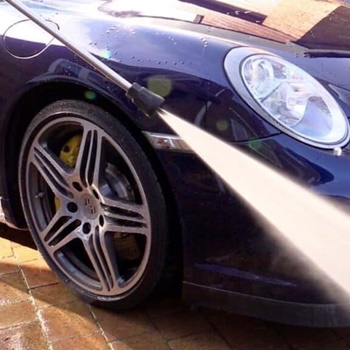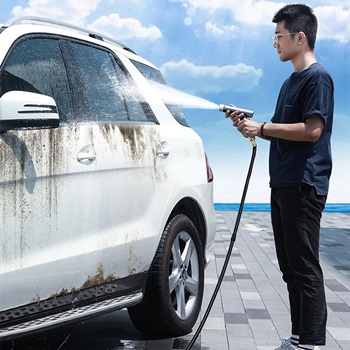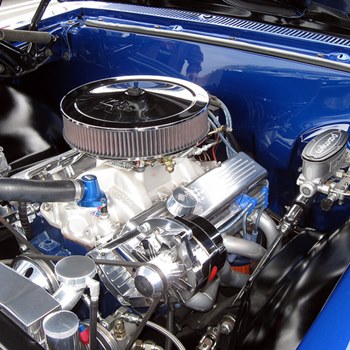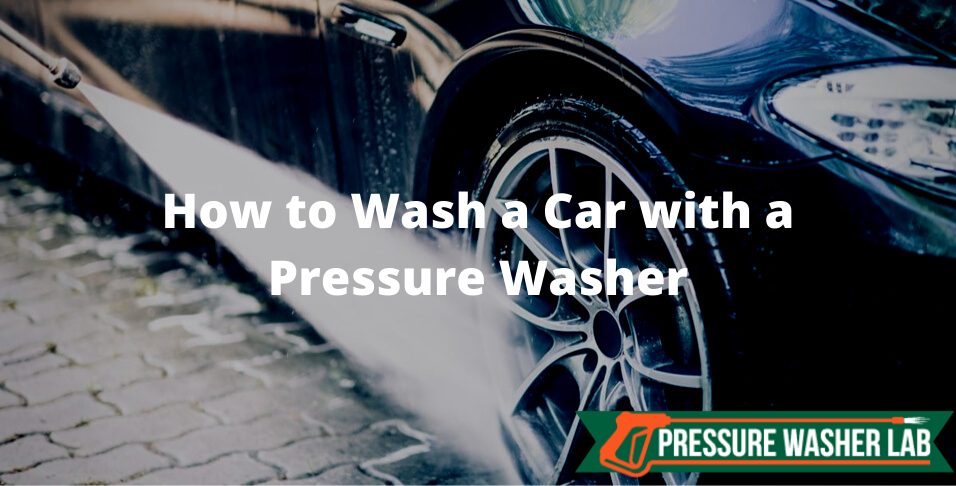To wash a car with a pressure washer, follow the steps given below:
- Step 1: Park the car in a safe and shaded spot away from objects or machines that can easily get damaged.
- Step 2: Get the pressure washer, pressure nozzles, attachments, and chemicals ready.
- Step 3: Rinse the car using the appropriate pressure washer.
- Step 4: Apply the chemicals and wait for the dirt to loosen up.
- Step 5: Rinse off the dirt and chemicals.
- Step 6: Dry the car.
Which Nozzles for Pressure Washing a Car?

The most appropriate nozzles for pressure washing a car are the 25-degree green tip nozzle and the 40-degree white tip nozzle. The green nozzle is great for a pre-rinse and the white nozzle to rinse everything off, post pressure washing a car.
The green head nozzle has a 25-degree angle, providing a narrower, more powerful stream. It is best used for a pre-rinse or to loosen up compacted mud from your wheels, but not for other parts of the car.
The white nozzle is the best all-purpose nozzle for pressure washing a car, as it cleans large areas very fast. It has a 40-degree spray angle, is safe to use on all car surfaces, and can be used to rinse off detergents as well. While this nozzle is safe to use on the car’s engine, extra caution should be followed.
Remember to follow the 1200 to 2000 PSI limit regardless of which nozzle is chosen. Exceeding the limits of 1.4 to 1.6 GPM could damage the vehicle.
There are two types of pressure washers: electric and gas-powered. The latter is not recommended for cars because they are too powerful and can damage the outer layer. An electric pressure washer is the best choice for cleaning a car.
Choosing the right nozzle for various tasks can be difficult, but this guide offers details on how to do it.
Useful Attachments and Chemicals for Pressure Washing a Car
If the pressure washer detergent tank is being used to apply the cleaning solution, use detergents and soaps. However, if there isn’t a detergent tank, use foam cannons and foam cannon soaps to do the job.
1. Pressure Washer Soaps and Detergents
Pressure washer soaps and detergents are specially formulated to have a neutral pH in order not to damage the paint layer. The best pressure washer soaps and detergents are made to clean the tough grease and oil that is stuck on the car’s surface, undercarriage, and engine.
2. Foam Cannons
A foam cannon is a piece of equipment that combines car wash soap with water and air. The foam cannon combines these in the right quantity to create thick foam that can be sprayed all over the car. The resultant mixture has a thick, foam-like consistency. A foam cannon can be used along with a pressure washer to use the high pressure to shoot foam onto the car.
The advantage of using a foam cannon is that it easily loosens up dirt just by shooting the foam onto the surface of the car. It also saves time, water, soap, and makes the rinsing process much easier.
3. Foam Cannon Soaps
Foam cannon soaps are especially made to be used along with a foam cannon. They give the right lathering texture and efficiency required to clean dirt off a car. Using just any soap in a foam cannon can’t give the same consistency that a foam cannon soap can, and will lead to suboptimal cleaning.
How to Pressure Wash a Car?

For pressure washing a car, the following items should be used:
- A water outlet
- Pressure washer detergents and soaps, foam cannon, or foam cannon soaps
- A bucket
- Microfiber towel
- Pressure washer
- Pressure washer nozzle or a pressure washer rotating brush for cars
- A power outlet
Step 1 – Park the car
The car should be parked in a shaded spot. Parking the car in a sunny spot will make the soap and detergent dry off faster. This slows down the rinsing process.
Objects and devices in proximity should be removed to avoid damaging them. If an electric pressure washer is used, it should be close to a power outlet and the cord should be long enough.
Not all electric pressure washers work with extension cords. Sometimes the extension cord might not support the power required by the washer and hence fail to work or perform weakly. The pressure washer needs to be compatible with the extension cord, or the existing cord has to be long enough.
All the windows, doors, trunks, and other openings should be closed before washing the car. Getting water into the interior can be disastrous. All accessories from the exterior of the car should be removed.
Step 2 – Rinse
The car should be rinsed with water. For this, the green nozzle needs to be attached to the washer and the washer should be plugged into the outlet. The pressure of the machine can be checked by first using it on the ground. After adjusting the pressure, the water should be sprayed on all surfaces and wheels of the car, from top to bottom. The dirt that is easy to remove can be rinsed off.
It is best to stand at a distance of 4 to 5 feet from the car when washing it, and move closer only after testing out the pressure. Rinsing the car with water helps loosen up the dirt and prepares the car for applying detergent.
A pressure of 1500 PSI should be used to clean a car. The water flow at 1500 PSI will be about 1.5 gallons per minute (GPM). Combining the pressure and amount of water will determine the total cleaning units of the pressure washer.
The equation for cleaning units is:
PSI GPM = Cleaning Units
For the above-given figures, this equation will be,
1500 PSI 1.5 GPM = 2250 Cleaning Units
When washing the car’s engine, the pressure should be lowered. The pressure of the washer should also be adjusted to reduce the PSI. A good range for the PSI when washing the engine is 1000 to 1200 PSI. If the green nozzle doesn’t allow this low of a setting, a white nozzle can be used instead.
The pressure decreases when the distance from the car increases, and vice-versa.
Step 3 – Apply chemicals
The detergent should be applied next. Since the detergent is sold in concentrated form, it should be diluted before use. The procedure can be performed in a bucket where water and cleaning agent are mixed, and added to the detergent compartment on the pressure washer. Using a washer with a detergent compartment, makes the process easier.
After switching on the detergent spraying setting on the washer, the entire exterior of the car can be sprayed with detergent. If the washer doesn’t have any such compartment, the solution will be applied by hand using a towel. The detergent should be rinsed until it mixes with the dirt on the car’s surface.
If the wheels have accumulated a lot of dirt or mud, using a 25-degree green nozzle is most appropriate.
If the car is too big to rinse all at once, the process can be done in stages. A side can be washed first and then another and so on.
Step 4 – Rinse off
The solution needs to sit for 5 minutes. After switching the water spray setting, everything should be rinsed off from top to bottom using a white head nozzle.
If there is still dirt left, the cleaning procedure can be repeated only for that part.
Step 5 – Dry it out
Using a microfiber cloth or a no-lint towel, the excess water from the car needs to be wiped off. A microfiber towel is extremely absorbent and sucks away the water quickly. The durable fibers on a microfiber cloth also help clear away some of the leftover dirt and particles from the surface. At the same time, these towels won’t scratch or damage the paint on the car.
When drying the car, special attention should be paid to the area around the rearview mirrors. Remaining dirt particles can be cleaned using a dry and clean microfiber cloth. During the drying process, the towel has to be rinsed and drained continuously.
Not even a small drop of water should be allowed to air dry on the car’s surface because leftover water contains minerals, which, once dry, can leave marks or damage the paint. A double-take is recommended to make sure the entire surface of the car is dry. One way to do this is by laying the microfiber towel flat on a part of the surface and patting it down for a few seconds, then repeating it for the rest of the car.
It is okay to use these steps when cleaning the undercarriage on a car as well.
Safety Tips for Pressure Washing a Car
1. Dos for the User
 It is better to point the nozzle at the ground and let the water pressure adjust before moving on to the car
It is better to point the nozzle at the ground and let the water pressure adjust before moving on to the car- The dirt and chemicals can be rinsed with a clean and soft bristled brush. The brush can trap dirt particles and scratch them against the surface, so it should be used with care
- If a sponge is used to rinse the detergent onto the surface, it should be cleaned after each use
- A pressure washer with a detergent tank is more easy to use
- All doors, windows, and trunk of the vehicle must be closed properly
- To protect the body from the high-pressure water and chemicals sprayed, wearing gloves, closed toed shoes, and covered clothes are a must
- An appropriate detergent for the car and the washer should be used
- The car should be washed from the top to the bottom and not the other way around
2. Don’ts for the User
- The pressure washer should not be used directly onto the engine
- It is not recommended using the most pointed nozzle attachment as its high-pressure can damage the car
- The nozzle needs to be kept at a safe distance from the surface
- High pressure shouldn’t be used on old tires, as they could explode
- The nozzle must not be held in one spot for too long because long exposure to high pressure water can strip away the paint
- A high-level of pressure should not be used on chipped paint either, as it could strip off the paint
- The cleaning agent must never be used before diluting it
- The car shouldn’t be parked on a gravely spot because the pressure from the washer can cause the pebbles to bounce off the car or hit the person nearby
- A pressure washer must never be used to spray paint or play with pets or children. The garden hose is a safer alternative
FAQs About Pressure Washing a Car
1. Can Pressure Washing Damage Car Paint?
Yes. But only if the pressure is too high or the wrong nozzle tip or detergent are used.
Pressure washing a car will not damage the car paint if the pressure limit of 1200 to 2000 PSI is maintained. To be on the safer side, using the lower limit is safer.
Pressure washing a car doesn’t cause the dirt to scratch the surface of the car – this is a misconception. The water jet creates a protective layer between the dirt and the car’s surface, while the car paint stays undamaged. There is still a risk of damaging the car paint when holding the washer too close, using high pressure, or using it on sensitive areas of the car.
Using a pressure washer on the corroded parts of the car or areas like the window seals can damage the car.
2. How Many PSI Does It Take to Wash a Car?
The safest PSI level range to wash a car is between 1500 and 1600. A PSI level up to 2000 PSI is considered safe for stubborn stains that need to be removed. A 3000 PSI can damage the car if not handled correctly. Along with the recommended PSI, the water flow level should be between 1.4 and 1.6 GPM.
3. Can You Power Wash a Car Engine?

Yes. It is safe to power wash a car engine, but with care. Reading the manufacturer’s manual before proceeding to power wash the car engine is important.
All vital components of the engine should be wrapped in plastic before beginning. After the washing is complete, the engine should be dried with a microfiber towel. Leaving the plastics on isn’t advised. Once the engine is turned on, the heat generated from it might cause the plastics to melt. To avoid this, all the wraps attached need to be removed.
For those living in snowy regions with salted roads: The auto engine should be cleaned at the end of every season with non-corrosive chemicals to keep it running efficiently for a long time.

